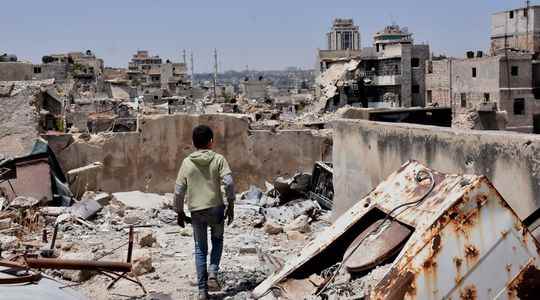In 2015, Moscow announced that it would stay only four months in Syria. In 2022, Russian troops are still there. The Syrian war was the ideal laboratory for Russia to test its military arsenal, train its ground troops and perfect its propaganda. The gap between the means implemented by the Russian army to support its ally Bashar el-Assad and the American disengagement in the region has allowed Vladimir Putin to do his preparatory classes in Syria, with complete impunity.
Aleppo, a city almost reduced to ashes by the Russians
The battle of Aleppo in 2016 is his textbook case. The large industrial city in northern Syria, split since 2012 between rebel factions in the east and regime forces in the west, folded under the deluge of fire from the Russian air force. As of September 19, 2016, more than 250,000 residents of opposition neighborhoods were besieged and bombed indiscriminately night and day by Russian missiles.
His Sukhoi planes Su-24s relentlessly targeted humanitarian convoys, hospitals, schools, buildings or markets in a clear scorched earth policy, with Moscow ready to burn the city to ashes, as it did against Chechen fighters in Grozny in 1999 “We were made like rats. I ran with my pregnant wife from building to building, praying that it wasn’t our last day,” says Imad, 35, now a refugee in Turkey, and for whom the images of the bombings in Ukraine brought back his traumas.
The show of force in Aleppo, which led to the fall of the city at the end of 2016, allowed the regime and its Russian allies to bring down other rebel cities one after the other, almost without a fight. According to the British NGO Airwars, Russia has been responsible for 23,400 civilian deaths since the start of its intervention in Syria on September 30, 2015.
This is, undeniably, the turning point of the war, which will help its Syrian ally to quickly reconquer three quarters of the territory. “Syria has proven to be a testing ground for capabilities, geopolitics and weapons,” said Ruslan Trad, analyst and co-founder of De re militari, a newspaper based in Bulgaria.
Moscow thus achieved massive gains at relatively low cost, deploying 4,000 to 5,000 troops and some 70 aircraft. “Russia managed to demonstrate the effectiveness of some of its advanced weapons and to make improvements during the campaign,” said Alexey Khlebnikov, expert at Riac, the Russian Council for International Affairs, in Moscow.
Syria, a playground for mercenaries and disinformation
“About 200 new weapons, some of which were improved during the air campaign from 2015 to 2017, were used in Syria, specifies Ruslan Trad. The mercenary model was also sophisticated, with Wagner [NDLR : le groupe paramilitaire] and other similar companies relocated from Ukraine to Syria, then from Syria to Africa and the Caucasus.” During its various outings, Russia was able to test and perfect its Su-24 bomber, put into service in 2014, which allows him to strike far from his base, but also his Su-25 or his Forpost and Orlan-10 drones.
Another weapon of Moscow deployed in Ukraine after being tested in Syria: its propaganda. As soon as they entered the war, the Russians made every effort to put rebel opponents and jihadists in the same bag. This demonization of the enemy, which justifies an intervention carried out in the name of the security of local populations, has proved its worth. In Aleppo, the White Helmets, a Syrian civil defense organization, will be victims of smear campaigns on social networks and Russian propaganda channels, portrayed as “rescuers” by day and “terrorists” by night.
This information war targets several audiences, since it seduces both the extreme left in an anti-imperialist logic, but also the right and the extreme right sensitive to the question of the defense of Christian minorities. On February 24, when the first bombardments hit Ukraine, in Idleb, Aziz al-Asmar, a local artist, painted, on the wall of a destroyed building, Putin on a bear invading Ukraine. “We feel what the Ukrainian people are going through right now. The Russian method has been tested and approved here,” said Khaled, a resident of this northwestern Syrian province.
